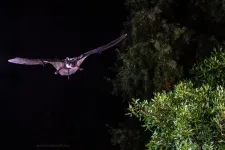Bats on the rise
Bats carried aloft to almost 2,000 metres by air currents
2021-02-09
(Press-News.org) Bats are the only mammals that can actively fly. Some species travel over one hundred kilometres on their nocturnal excursions in search of food. Researchers at the Max Planck Institute of Animal Behavior in Radolfzell have now discovered that European free-tailed bats use uplifting winds for their ascents - a behaviour that was previously known only from birds. To do this, they tracked the bats using mini GPS loggers and then linked the flight data to weather data. The animals can thus gain altitude of well over 1,000 metres without expending much energy. The results also show that the bats reach flight speeds of up to 135 kilometres per hour.
Thanks to the development of small yet powerful GPS transmitters, researchers can accurately track the flight paths of bats. Together with colleagues from Portugal and the US, researchers from the Max Planck Institute of Animal Behavior in Radolfzell have fitted European free-tailed bats with such transmitters. The astonishing findings on the flight behaviour of these small mammals have been made possible only by the international cooperation of experts in animal behaviour, meteorology, biomechanics, and modelling.
Analysis of the GPS data has revealed that the bats often follow the natural course of the landscape and maintain the same height above the ground. However, every now and then, they literally shoot upwards only to plummet down again - a behaviour that researchers call a roller-coaster flight. The bats climb 300 to 800 metres in the process. One bat even reached a peak value of 1,680 metres above the ground.
The scientists suspect that the bats do this in order to get an overview of the landscape or look for swarms of insects. "Or maybe they are just having fun", says Teague O'Mara, lead author of the study, who is now conducting research in the US. It is easy to explain why the animals plunge down again directly after the ascent: bats cannot glide for long. Their wings are not made for that; they are too flexible and stretchy. That is why they cannot use the gain in altitude for an extended gliding flight as storks do, for example.
Obstacles cause upwinds
The ascents, during which the bats gain up to 4.5 metres of height per second, would be enormously energy-sapping for the small animals in active flight. The researchers therefore investigated whether the animals take advantage of favourable winds. This behaviour is known from some bird species (e.g. vultures and storks), which soar upwards with the help of thermal updrafts. However, thermals develop only when the sun strongly heats the ground and thus the lower layers of air. At night, the bats must therefore use other types of uplifting wind. A close analysis of the flight paths revealed that they probably use the upward movement that occurs when winds cross obstacles such as mountains and other elevations.
However, it is still unclear how the animals find these places. They may recognize favourable landscape features such as steep slopes. They could learn from their positive experiences in these places and repeatedly seek them out. "Our results are only a small, initial glimpse. But they open up an exciting new research field", explains Dina Dechmann, group leader at the Max Planck Institute in Radolfzell.
In an earlier study, she and her colleagues measured flight speeds of over 150 kilometres per hour in the smaller Mexican free-tailed bat - a result that was received with some scepticism in the research community. However, the new data measured with even better methods confirm these earlier results and indicate a similar peak value of 135 kilometres per hour for flight under their own power - speeds that, to date, are exceeded only by birds in nosedive. "We don't know how the little animals reach these astounding speeds", says O'Mara. Almost all of the power for the wing beat comes from the pectoral muscles, which are only about two centimetres long.
INFORMATION:
Original publication
M. Teague O'Mara, Francisco Amorim, Martina Scacco, Gary F. McCracken, Kamran Safi, Vanessa Mata, Ricardo Tomé, Sharon Swartz, Martin Wikelski, Pedro Beja, Hugo Rebelo, Dina K.N. Dechmann
Bats use topography and nocturnal updrafts to fly high and fast
Current Biology; 4 February, 2021
[Attachments] See images for this press release:

ELSE PRESS RELEASES FROM THIS DATE:
2021-02-09
DNA sequences that can fold into shapes other than the classic double helix tend to have higher mutation rates than other regions in the human genome. New research shows that the elevated mutation rate in these sequences plays a major role in determining regional variation in mutation rates across the genome. Deciphering the patterns and causes of regional variation in mutation rates is important both for understanding evolution and for predicting sites of new mutations that could lead to disease.
A paper describing the research by a team of Penn State scientists is available online in the journal Nucleic Acids Research.
"Most of the time we think about DNA as the classic ...
2021-02-09
A 'biological age' score predicts that being male, overweight, a smoker and having depression all contribute to biological aging, a study published today in eLife reports.
Aging can be measured in different ways. While chronological age is measured by date of birth, scientists have developed a range of measurements to determine our biological age. These include measuring the length of telomeres (little caps on the end of our chromosomes that shorten as we grow older), chemical changes to our DNA (epigenetics), and changes to the proteins and metabolites in our bodies ...
2021-02-09
According to the Education Act, schools in the ethnically divided Bosnia and Herzegovina must teach students "democratic ideals in a multicultural society." But according to new research from the University of Copenhagen, the opposite happens: Segregated schools perpetuate ethnic divisions between Croats, Serbs and Bosniaks, making reconciliation after the 1992-1995 wars extremely difficult.
25 years ago, the warring factions in the war in former Yugoslavia signed a peace agreement. Bosnia and Herzegovina, where 100,000 people lost their lives during the war, is now an independent state comprising the Bosnian-Croatian Federation and the Republika Srpska. It is a division that ...
2021-02-09
Social conflicts, from policy debates to family disagreements, can easily devolve into angry words and personal attacks. Such heated confrontations, however, seldom resolve disagreements and can entrench opposing views.
A better approach to resolving interpersonal disagreements is to embrace characteristics that psychological scientists associate with wisdom, like intellectual humility, diverse viewpoints, and open-mindedness.
But applying these elements of wisdom can be difficult, especially during confrontations. The trick, according to new research published ...
2021-02-09
The global problem of unowned domestic cats, driven by the cats' phenomenal reproductive success, carries significant economic, animal welfare and biodiversity costs. Big-data research led by an expert on veterinary medicine and infectious diseases at City University of Hong Kong (CityU) has found that although more than 80% of cats in Australia were desexed, only a fraction have had surgery before reaching puberty, thus creating a "pregnancy gap". To close this gap and prevent unwanted litters, it is recommended that the age of desexing is before four months.
The research was led by Professor ...
2021-02-09
OAK BROOK, Ill. - Breast cancer death rates have stopped declining for women in the U.S. younger than age 40, ending a trend that existed from 1987 to 2010, according to a new study in Radiology. Researchers expressed hope that the findings would raise awareness of breast cancer in younger women and spur research into the causes behind the change.
Breast cancer is the most common non-skin cancer and the second most common cause of cancer deaths in women in the U.S., accounting for 30% of all cancers in women. Although most invasive breast cancers occur in women age 40 years and older, ...
2021-02-09
Scientific and public health experts have been raising the alarm for decades, imploring public officials to prepare for the inevitability of a viral pandemic. Infectious epidemics seemingly as benign as "the flu" and as deadly as the Ebola virus provided ample warning, yet government officials seemed caught off guard and ill prepared for dealing with COVID-19. Three future-oriented researchers and policy experts map out an "Epidemiological Blueprint for Understanding the Dynamics of a Pandemic."
COVID Detectives
Researchers around the world have become forensic, Sherlock Holmes-like "consulting detectives" for government officials and public health organizations. Handling tens of thousands ...
2021-02-09
In the span of only 15 years, a small academic elite has increased its share of academic citations significantly. In the year 2000, 14 per cent of all citations went to the top one percent of the most cited researchers. New research shows that this figure had risen to 21 per cent in 2015.
The people behind these remarkable findings are senior researcher Jens Peter Andersen, Danish Centre for Studies in Research and Research Policy (CFA) at Aarhus BSS, Aarhus University, and associate professor Mathias Wullum Nielsen (former CFA, now University of Copenhagen). Their examination of almost 26 million scientific papers and four million authors has just been published in the well-established interdisciplinary journal Proceedings of the National Academy of Sciences ...
2021-02-09
Animal owners frequently report concerns and worries relating to caring for their animal during the pandemic, new research suggests.
The study, by the University of York, also revealed owners had increased their appreciation of their animals during the first lockdown phase. The notion that people "could not live without" their animals and that they were a "godsend" or a "lifeline" in the pandemic was frequently expressed.
The study has been investigating the role of animals as sources of emotional and physical support during the pandemic. More than 40 per cent of UK households are estimated to own at least one animal.
There was consensus among participants that companion animals constituted a reliable source of support, providing unconditional love, ...
2021-02-09
When human cells have to adapt due to a wide variety of external influences, the BAF complex plays a central role because it controls the accessibility of the DNA and thus the information stored in it. In every fifth human cancer, a mutation is found in one of the BAF complex genes. Scientists from the research group of Principal Investigator Stefan Kubicek at the CeMM Research Center for Molecular Medicine of the Austrian Academy of Sciences have investigated this complex in more detail using novel techniques and were able to show how quickly changes in the BAF complex genes influence the accessibility of DNA. The study has now been published in Nature Genetics.
Chromatin is a central component of the cell nucleus and refers to the material that ...
LAST 30 PRESS RELEASES:
[Press-News.org] Bats on the rise
Bats carried aloft to almost 2,000 metres by air currents






